The poinsettia is one of the most popular festive plants to put on display over the holidays – second only to the iconic Christmas Tree!
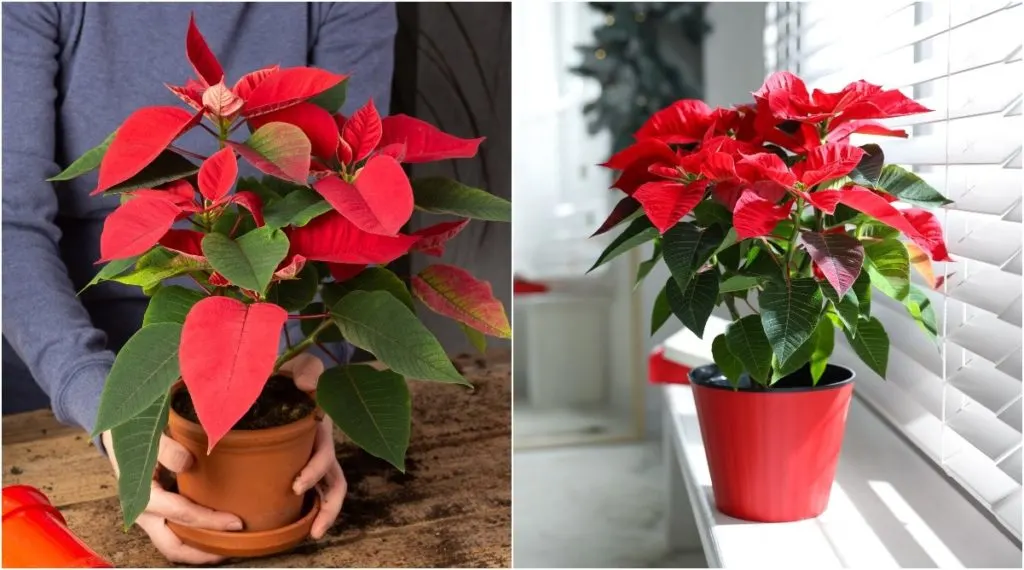
The fiery red and deep green leaves are the perfect color schema for the season. Though nowadays, there are so many non-traditional varieties to choose from, in whites, pinks, yellows, greens, and variegated hues.
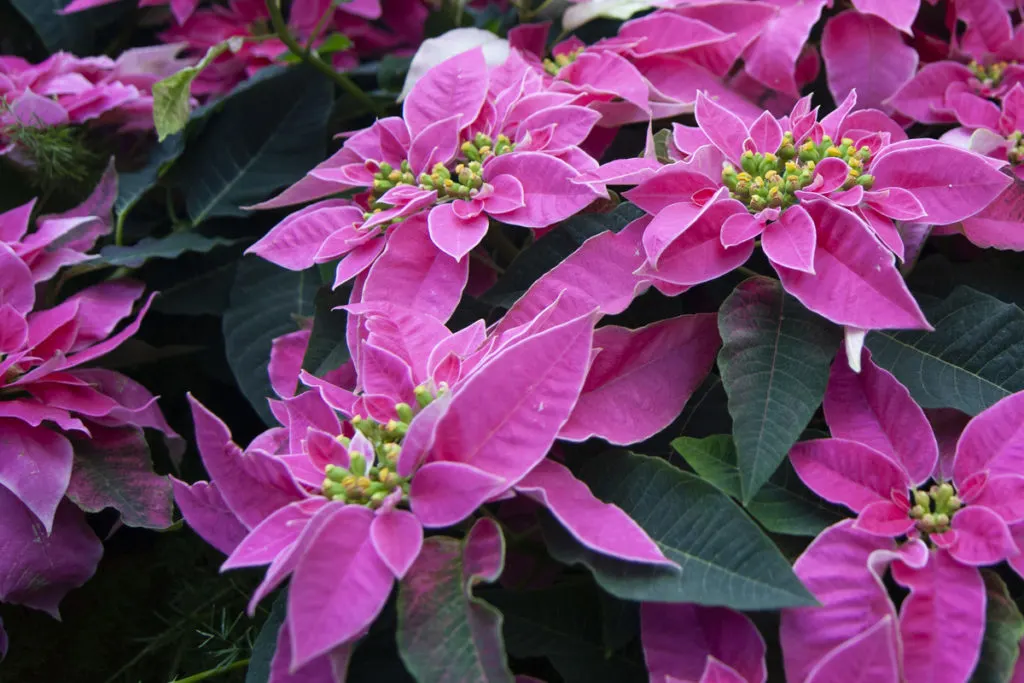
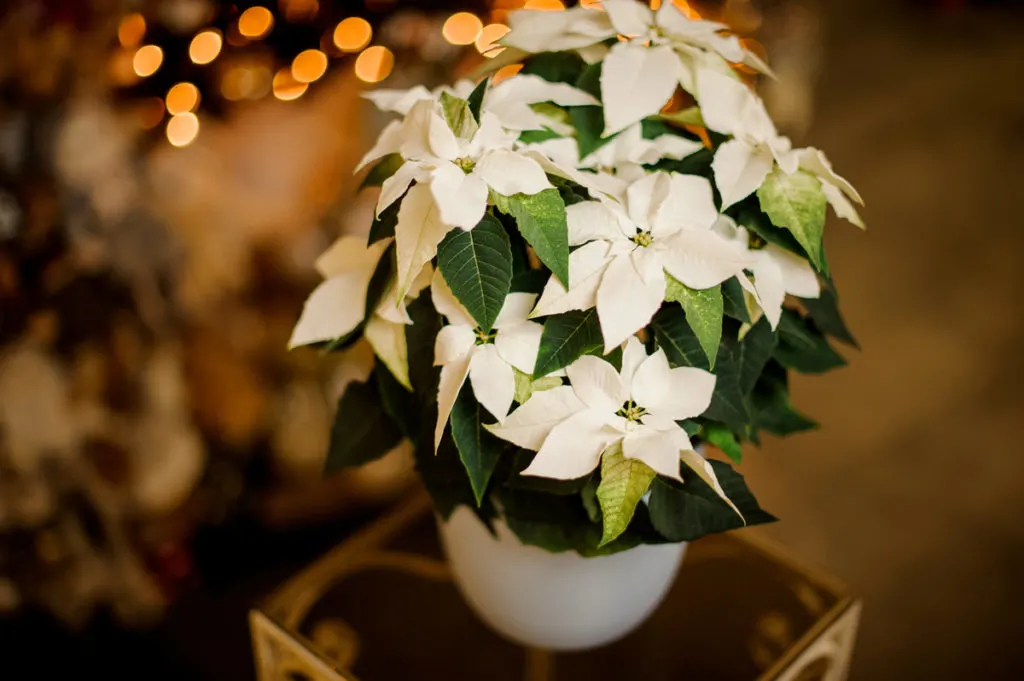
The vibrant color and warmth poinsettia brings to the home will last through the holidays, but come January plants can begin to wither and fade. Many will meet their end in the compost heap.
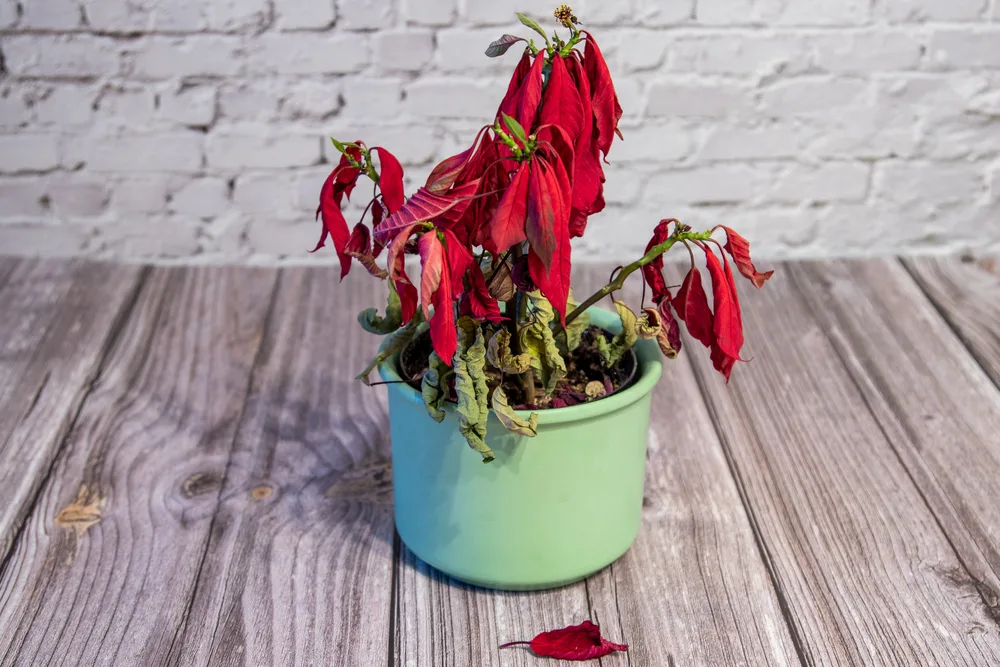
If you can’t stand the thought of tossing this beauty away, poinsettia can indeed be brought back to her former glory with the proper care.
Tracey detailed the exact process to keep your poinsettia alive year round and how to get the leaves to turn red again in her brilliant guide here.
If you’ve bought yourself a poinsettia plant this year, here are 22 things you need to know about your plant.
About Poinsettia Plants
1. Poinsettias are Semi-Tropical Plants
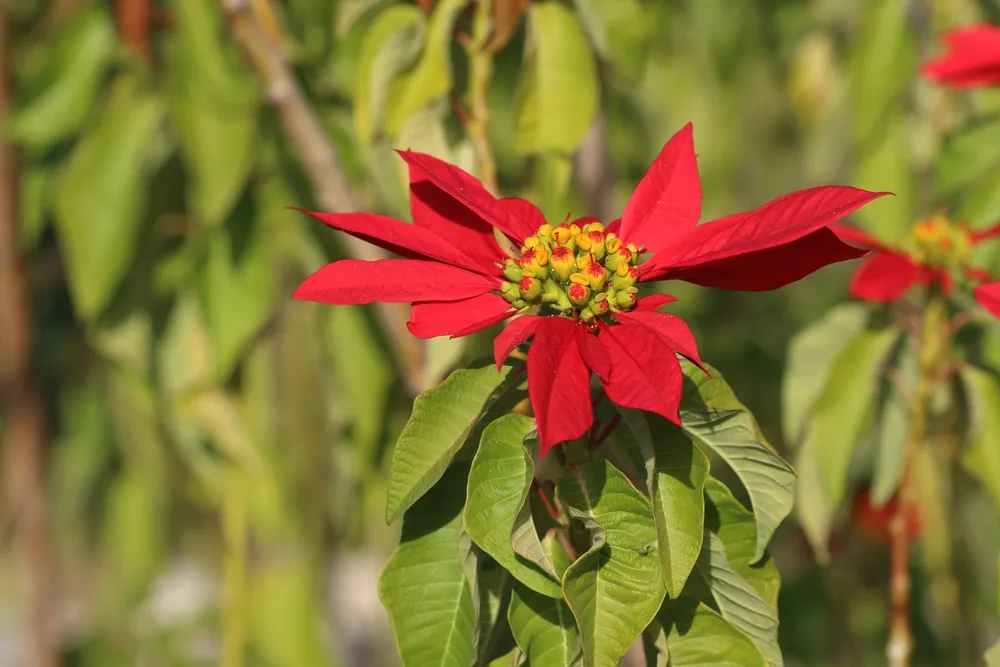
Poinsettia (Euphorbia pulcherrima) is a deciduous plant native to the subtropical dry forests of Mexico and Central America.
In its natural habitat, poinsettia is a multi-branched shrub or small tree that grows up to 15 feet tall along deep canyons and Pacific-facing slopes. Here it thrives in part sun and moderate temperatures that never drop below freezing.
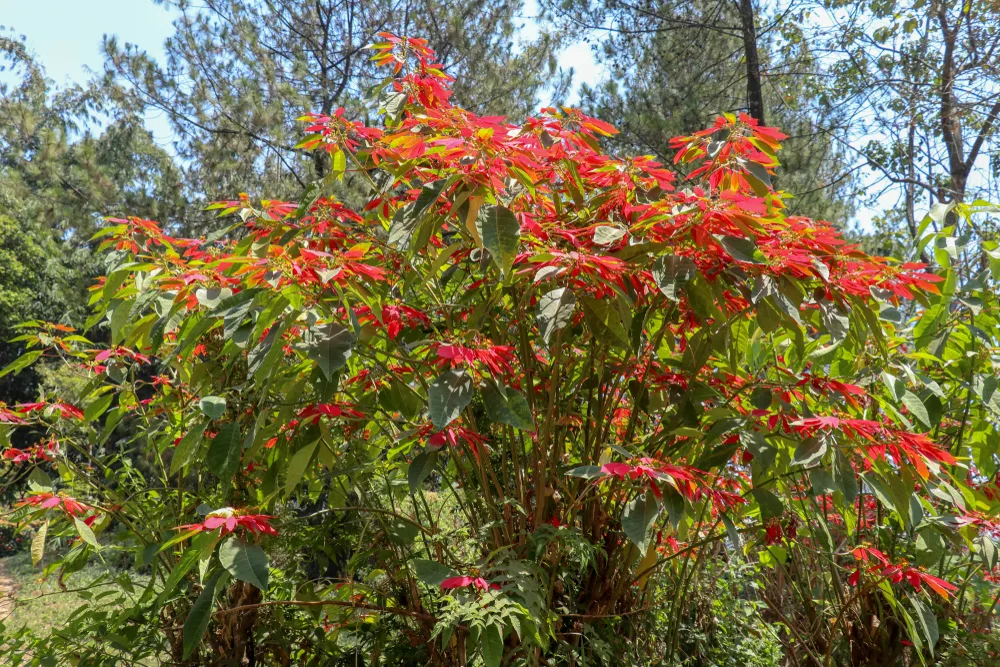
Through mid-winter, when days are shorter and nights are longer, the tops of poinsettias turn a flaming red hue.
2. Poinsettia’s Colorful Blooms are Actually Modified Leaves
What usually gets referred to as the poinsettia flower petals are really colorful bracts.
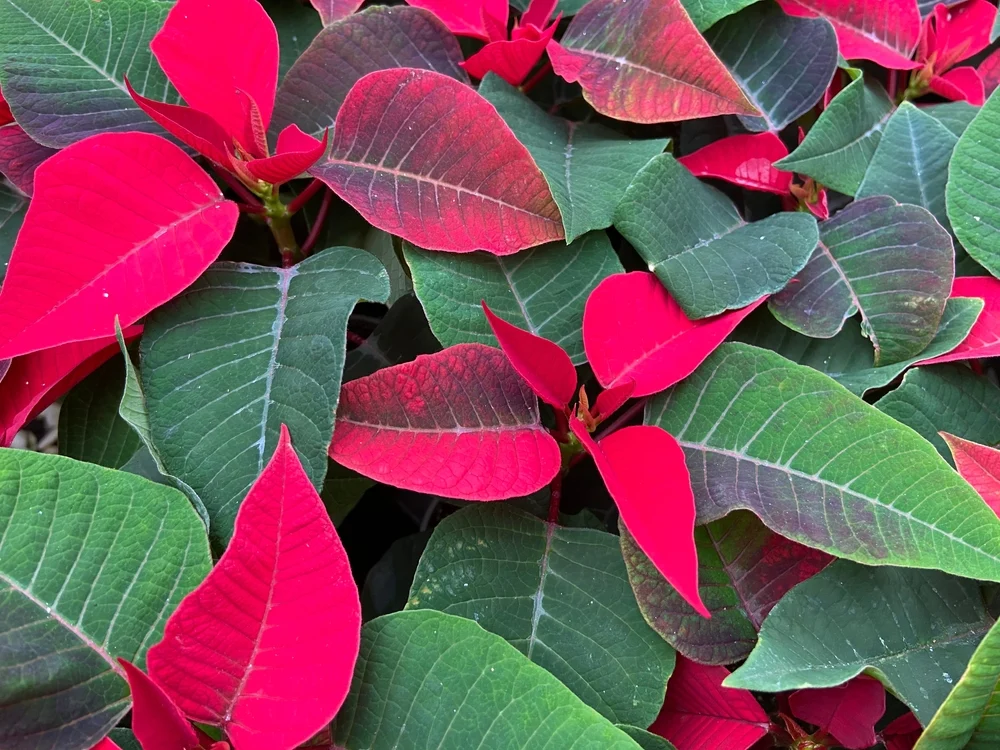
These modified leaves surround the true floral inflorescence – a small cluster of yellowish buds in the center – known as the cyathia.
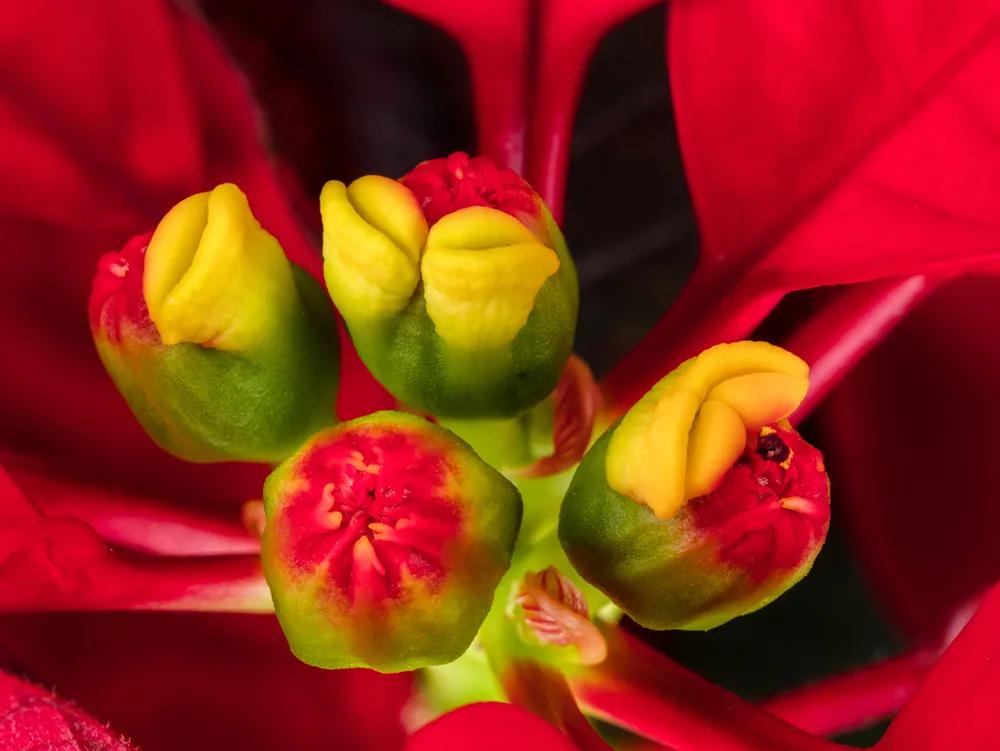
Poinsettia has green foliage throughout the year. Shorter days triggers its flowering period, when the cyathia will be begin to form at the tips of each branch. These tiny buds will spout the leafy bracts.
Green at first, the bracts will slowly transition to a rich red color.
3. Poinsettias are Short Day Plants
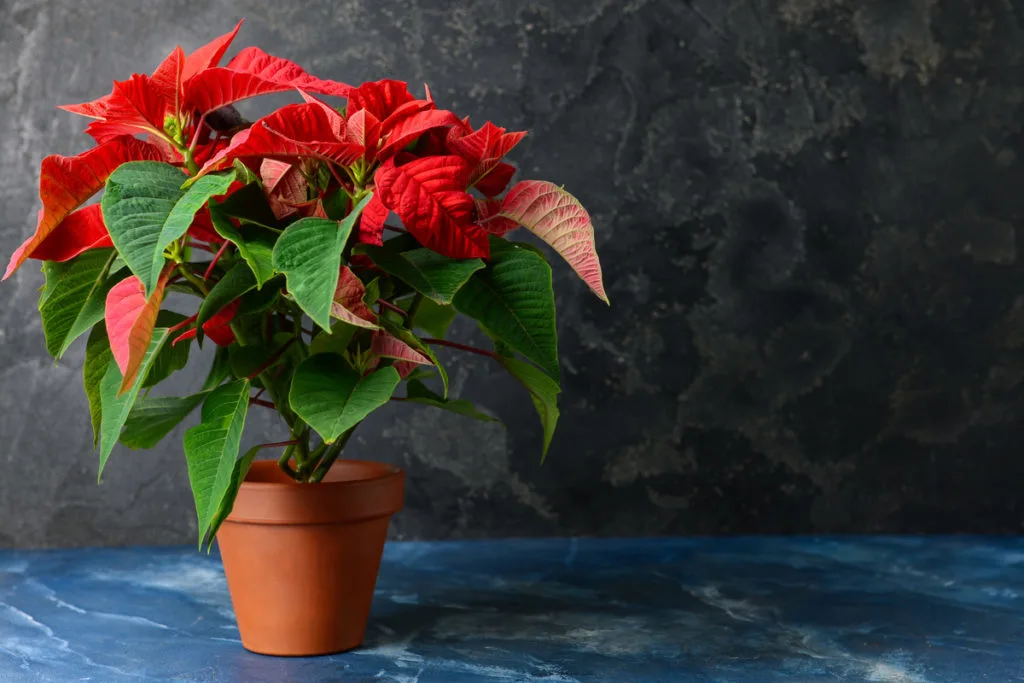
Like Christmas cactus, Chrysanthemum, and other late season bloomers, poinsettias are short day plants that are sensitive to changes in day length.
The reduced hours of daylight, which occurs naturally in wintertime, signals to the plant that it’s time to start flowering.
As the tiny flowers start developing in the center, poinsettias will stop producing chlorophyll (the pigment that makes plants green).
As the green-ness of the bracts fade away, the color will be slowly replaced by more and more reddish hues.
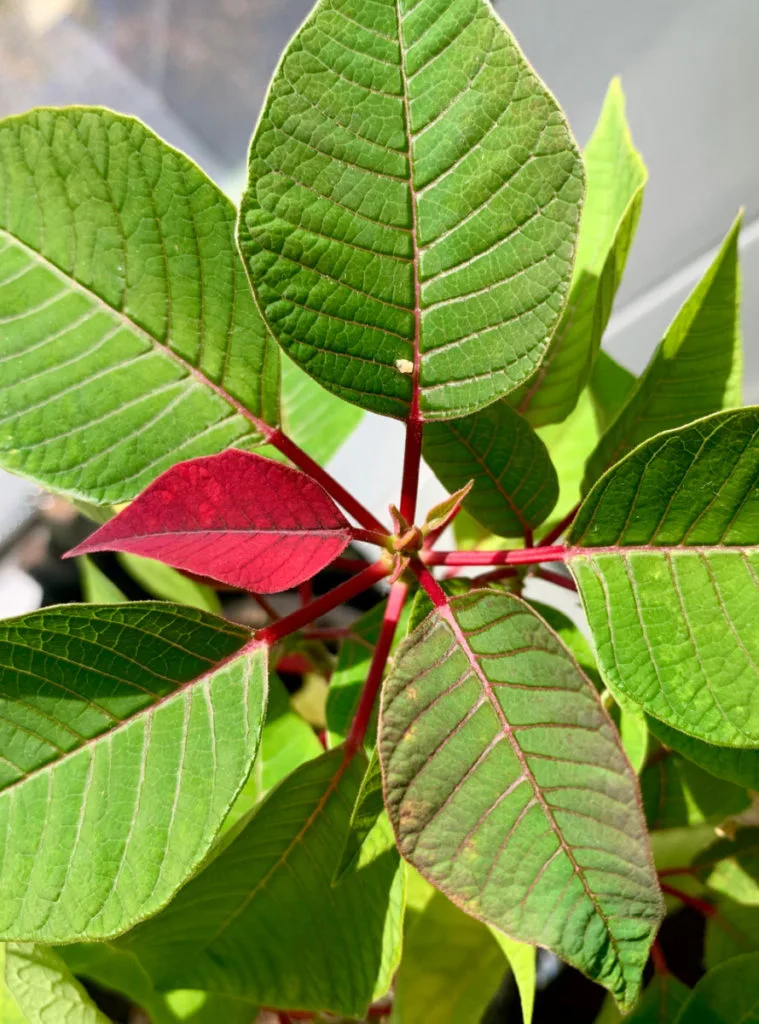
The eventual crimson color of poinsettia blooms are caused by a sharp increase in anthocyanins (the pigments that makes plants red, blue, purple or black).
4. Poinsettias Aren’t Poisonous
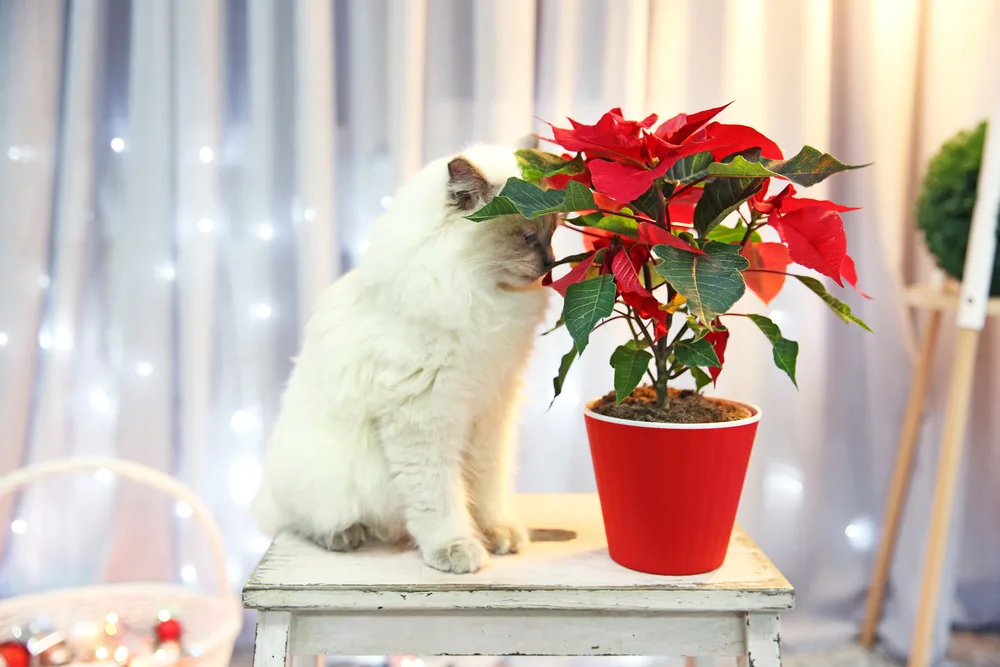
The belief that poinsettias are highly toxic to humans and animals has been circulating for over a hundred years. Tracey dispelled this myth recently in her article on holiday plants that are (and aren’t) toxic to pets.
It all started based on a rumor of a young child who died after eating a single poinsettia leaf, back in 1919. And like any good urban legend, the story spread far and wide, and is an oft-repeated warning to poinsettia owners today.
But poinsettias are completely undeserving of a toxic reputation.
Scientific studies conducted on the fatal dose of poinsettia leaves have found that…there is no fatal dose. You could eat upwards of 600 poinsettia leaves and maybe experience a slight tummy ache.
If children or pets munch on your plants, there’s no need to panic. In most cases, there’s little to no effect at all. At worst, symptoms are mild – nausea, vomiting, or diarrhea – and do not require medical intervention.
Even so, it’s probably wise to keep poinsettias up and out of reach of wandering nibblers.
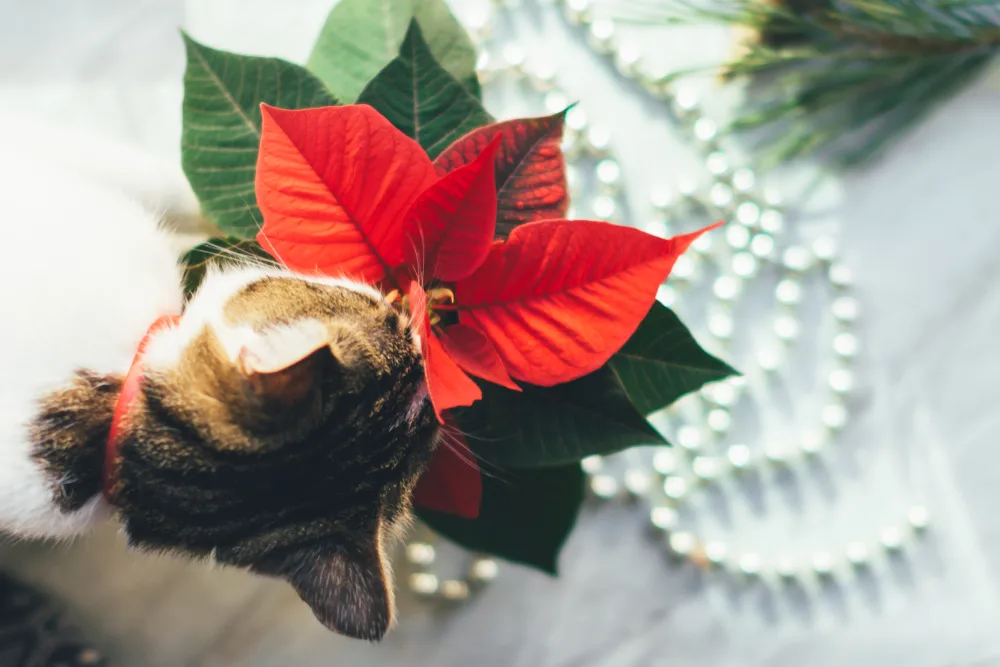
Although it’s certainly not deadly, poinsettia foliage can be irritating to people with latex allergies or eczema. For some, handling the plant (or its sticky sap) will cause a rash wherever it was touched.
5. There are 200+ Varieties of Poinsettia
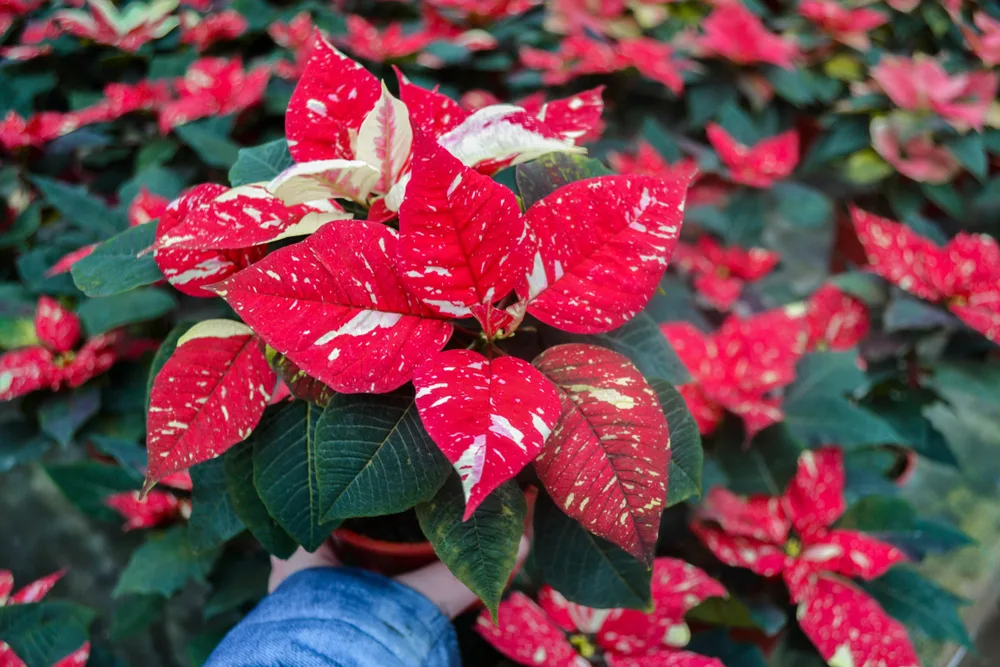
The original bright red color of poinsettia blooms are what the plant is most famous for. And for a long time, red was the only variety you could get.
But poinsettias are a booming business, with 70 million sold every year in the US during the holiday season.
It’s such a popular plant that breeders have gotten pretty creative in developing an enormous collection of poinsettias.
So far, there are more than 200 poinsettia cultivars to choose from, in a vast array of solid colors and variegated hues, with varying flower forms, bloom times, leaf shapes, and sizes.
While red poinsettias will always be the classic choice (and there are over 90 varieties in practically any shade of red you could imagine), less traditional options include poinsettias with pink, white, yellow, and green blooms.
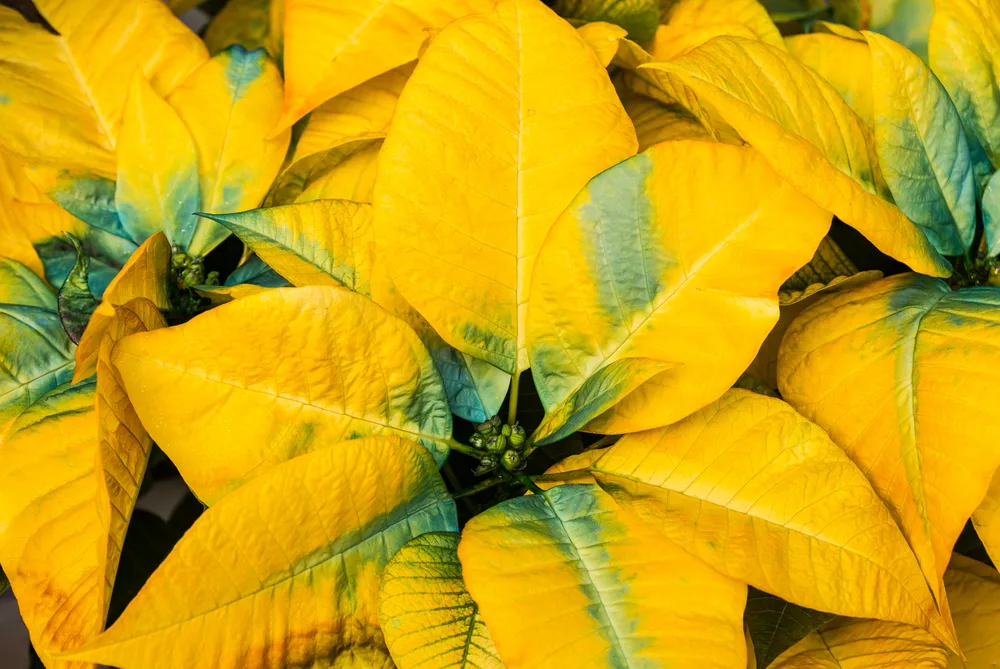
Variegated poinsettias offer dozens of new colors and color combinations. Jingle cultivars are speckled and spotted. Peppermint types have bracts that look like they’ve been softly dusted in color. The blooms of marbled varieties feature a lighter hue along the outer edges of each bract.
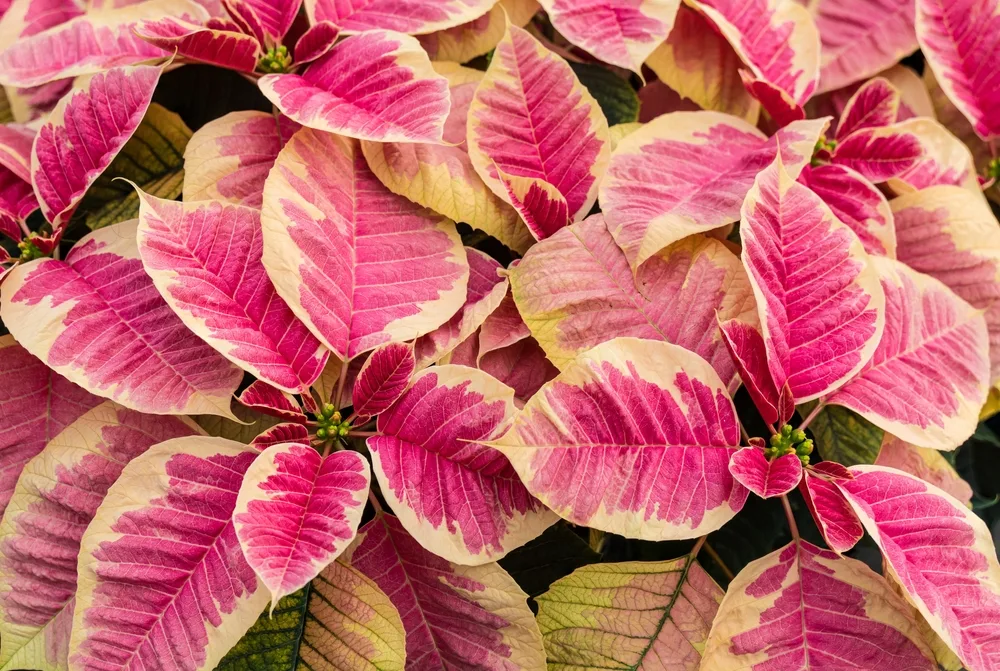
Even more curious are the novelty types that completely alter the look of poinsettias.
Instead of flat leaves, these ones have ruffled, wavy, or curled bracts, smaller but more numerous blooms, or some other flowering trait that renders them almost unrecognizable as poinsettias.
Winter Rose, Carousel, Princettia, and J’Adore ain’t your mama’s poinsettia!
Bringing a Poinsettia Plant Home
6. Spot the Signs of Good Vigor
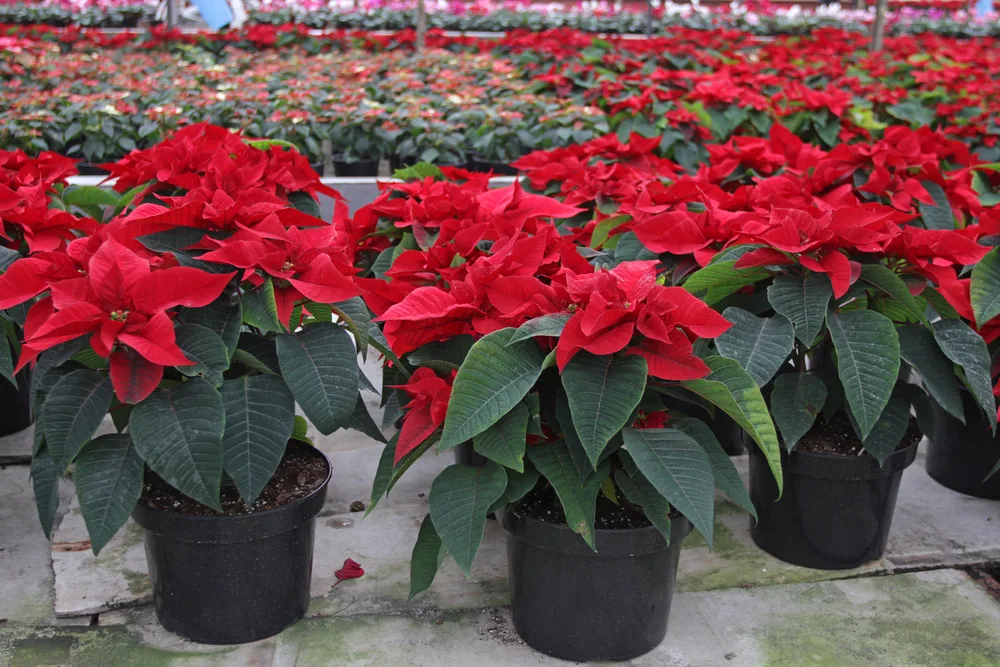
You’ll want the beautiful blooms to last through the holidays so be selective when picking out a poinsettia to bring home with you.
The plant should appear to be healthy and strong, with full foliage and balanced branching that looks good from all sides.
The bracts should be full of color, with no green around the edges. The foliage at the soil line should be dark green.
If it has yellowing, drying, or dropped leaves, put it back and find another.
7. No Yellow Pollen is Good
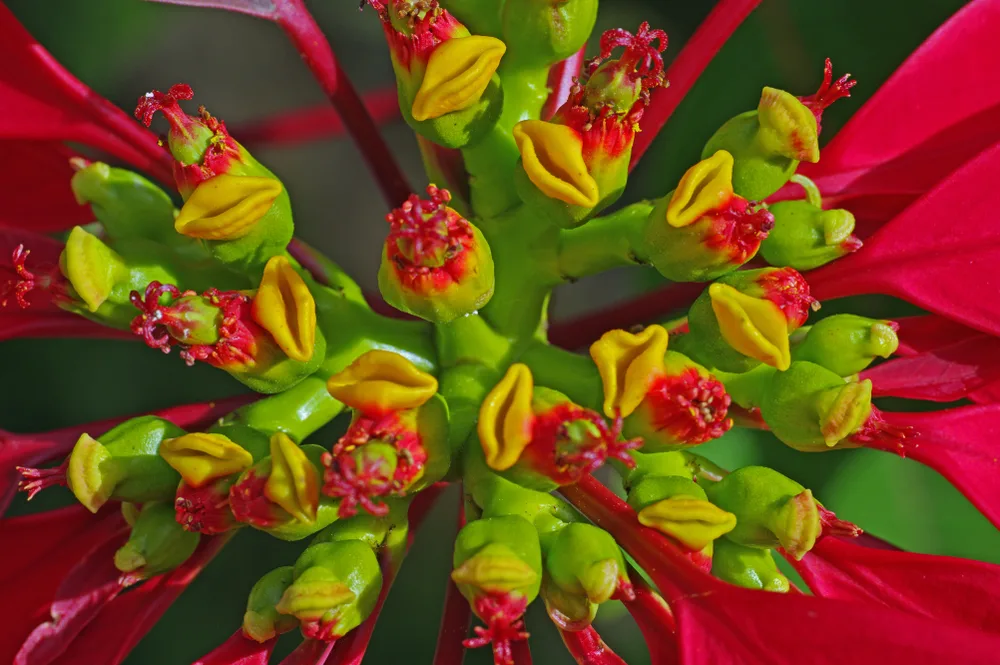
The cyathia – the true flowers of the poinsettia – has got to be one of the strangest inflorescences out there.
Look closely at a mature poinsettia’s cyathia and you’ll see a cluster of green bud-like structures, each with two bright yellow cups that hold nectar. The male flowers emerge from on top, a flurry of red stamens, long and upright, each with a tiny yellow dot of pollen at the end. The female flower will eventually appear above the male ones, a small green bulb topped with red pistils that arch down toward the stamens below.
Once the female parts are in action, and the flowers have shed all of their pollen, the poinsettia’s bloom time is officially over. Soon after, the showy bracts will drop from the plant.
For the longest lasting poinsettia blooms, look for plants with an immature cyathia. The center of buds should be mostly green and closed up, with little to no pollen showing.
Choosing a younger plant will ensure you have several weeks of excellent color.
8. Poinsettias Don’t Like the Cold
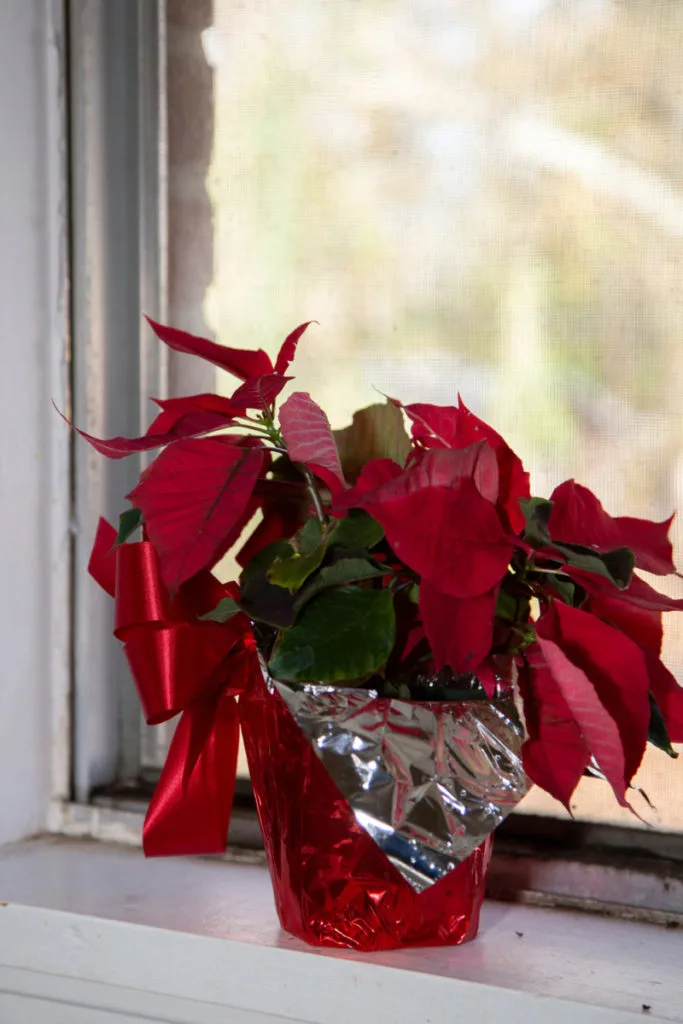
Poinsettias are warm climate plants that don’t do well when exposed to cold.
Even mildly cool temperatures of less than 50°F (10°C) is enough to damage poinsettias and cause them to start dropping leaves. Freezing temperatures will absolutely end them.
Since they’re so sensitive to cold, it’s always best to avoid purchasing poinsettias from stores that display the plants at or near the entrance. Constant exposure to cold drafts stresses the plant easily.
When you pick up the poinsettia, the container should not feel cold to the touch.
The poinsettia might look fine now, but will start losing its vigor a few days after you’ve brought it home.
9. Wrap it Up Before You Go
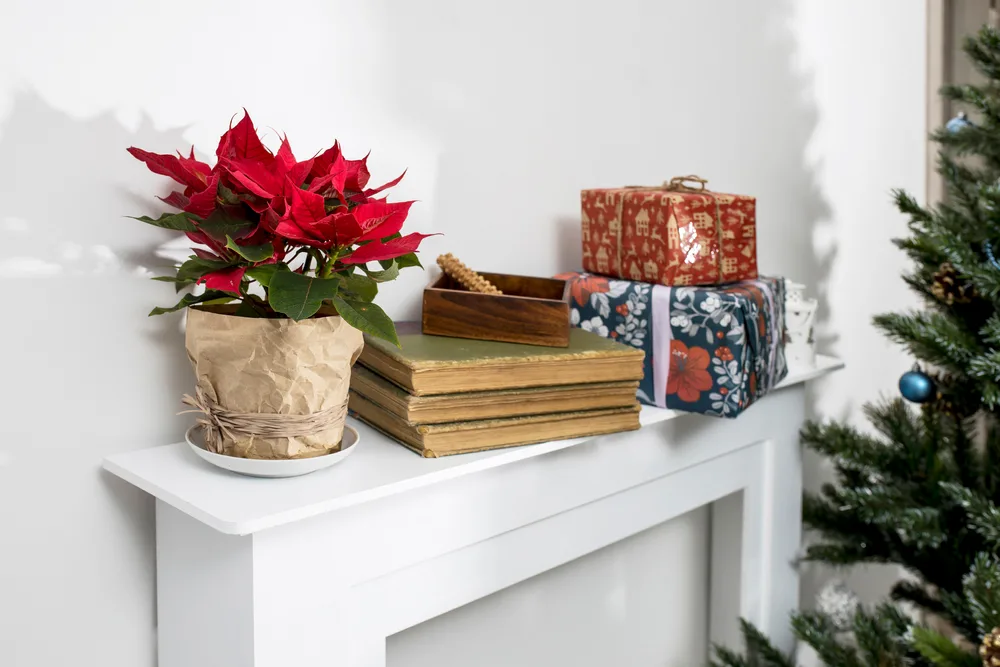
Once you’ve located the perfect poinsettia specimen – that is, a gorgeously colored and healthy plant with green cyathia that was kept in a warm spot – make sure you protect it from cold for the journey home.
Before leaving the store, have it wrapped up in paper to keep the cold out.
Once it’s back inside a warm abode, remove the protective wrapping right away.
Caring for Your Poinsettia Over the Holidays
10. Poinsettia Appreciates Lots of Bright, Indirect Light
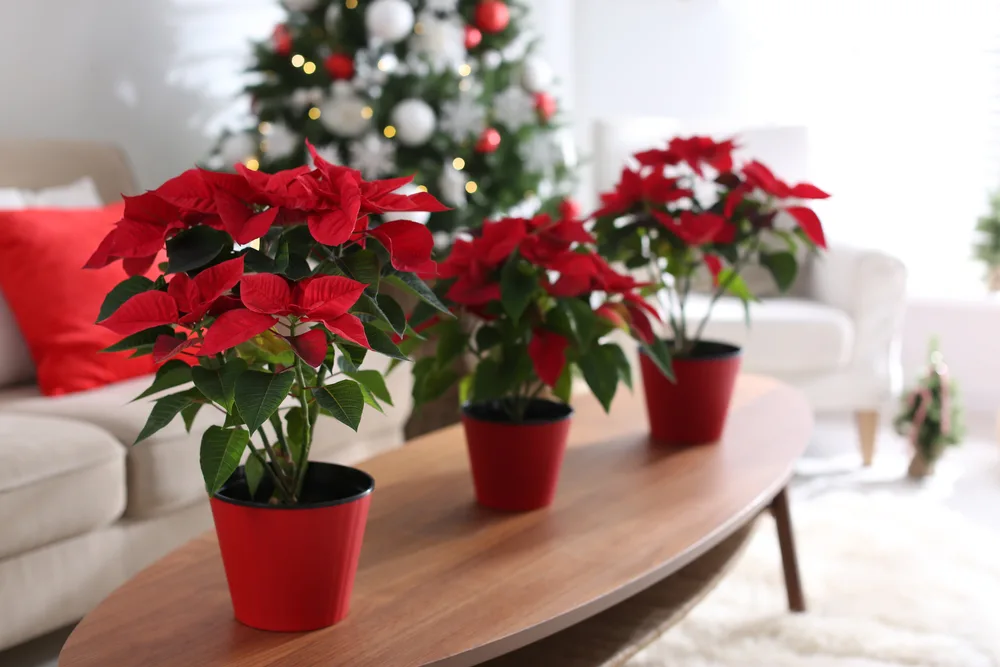
During the winter blooming time, poinsettias like plenty of bright light.
A room with a southern, eastern, or western exposure is best, placed in a spot where sunlight won’t shine directly on the foliage.
Poinsettias can adapt to less light but blooms will last longer when given between 6 to 8 hours of bright light every day.
11. Poinsettias Are Happiest in Moderate Temperatures
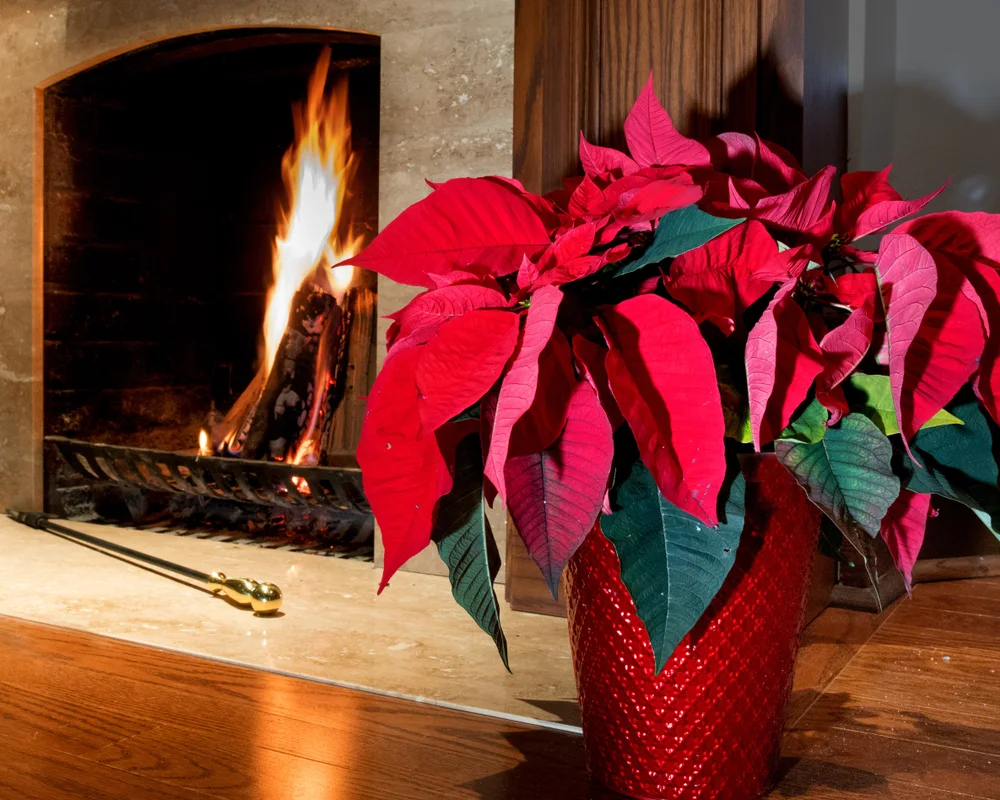
Poinsettias are easygoing when kept as indoor plants, preferring the same room temperatures as we do: 65°F to 70°F (18°C to 21°C).
Keep plants in even, moderate conditions and they’ll be at their best, putting out a long lasting show of flowers.
Any fluctuation in temperature can shorten poinsettia’s blooming time and cause leaves to drop.
We already know that poinsettias don’t like the cold, so keep it away from drafty spots in the home.
Sources of heat stresses poinsettias too. Don’t put them near heat ducts, radiators, fireplaces, space heaters, or anywhere the temperature exceeds 71°F (22°C).
12. Water Poinsettias Deeply, About Once a Week
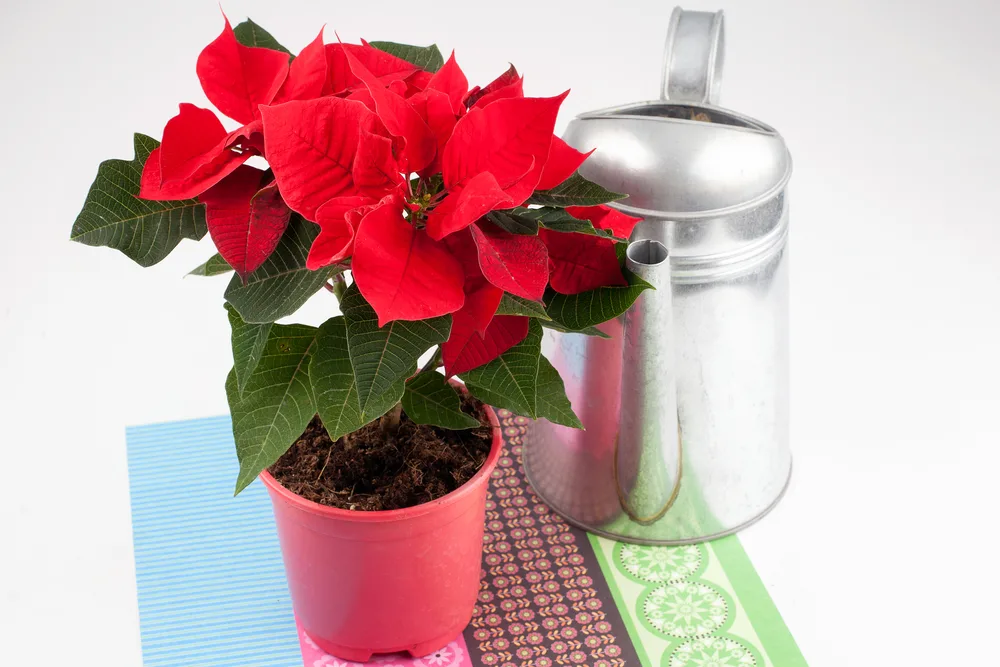
Poinsettias like consistently moist soil – not too wet and never completely dry.
Check the soil daily by running your fingers over the surface. Wait until the top layer of soil is dry before giving the plant good soak.
If your poinsettia came with decorative foil around the pot, pop it off for now.
Place the plant in the sink and water thoroughly – you’ll want to saturate the soil until water freely flows through the drainage holes on the bottom of the container.
Let it drain really well before replacing the foil. You never want to let poinsettia sit in excess water, which will rot the roots.
Overly soggy soil will cause the lower leaves to turn yellow and fall off. Wilting plants that start dropping leaves is a sure sign of under-watering.
When you water plants deeply, you should only need to do it about once a week.
Caring for Poinsettias Past Christmas
13. Poinsettias are Great Houseplants All Year Round
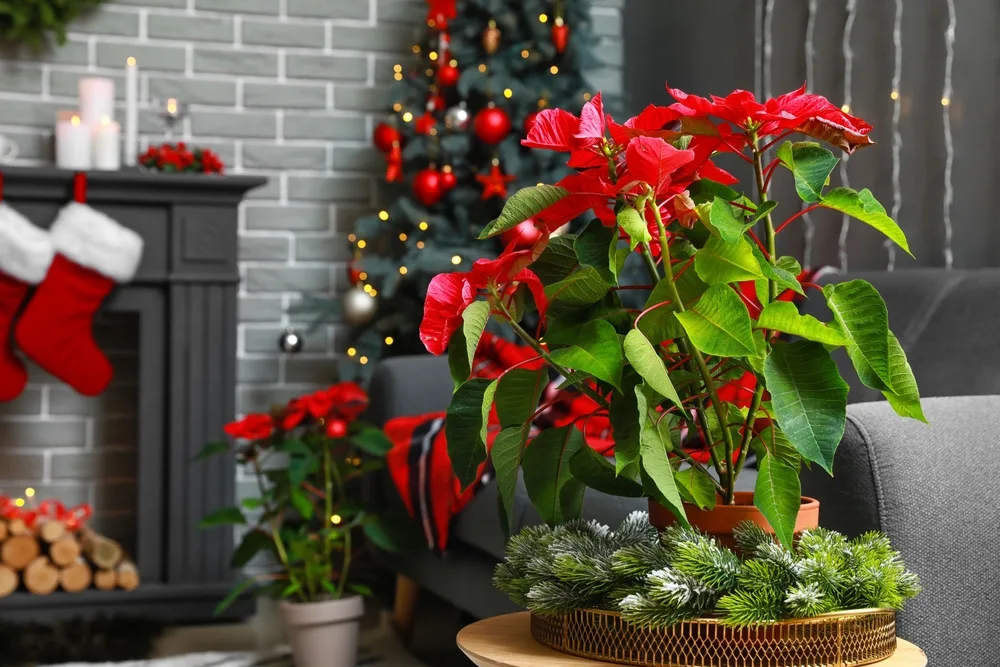
The vibrant blooms of poinsettia are certainly the most beloved aspect of the plant, and these can persist from Thanksgiving, through Christmas, and even until Valentine’s Day.
But along with the Christmas tree, poinsettias usually get tossed during the post-holiday clean up.
Even without its flashy bracts, poinsettia is still a looker. The deep green and broad leaves whirl around red, branching stems. The foliage at the top gathers loosely in a rosette, much like a flower.
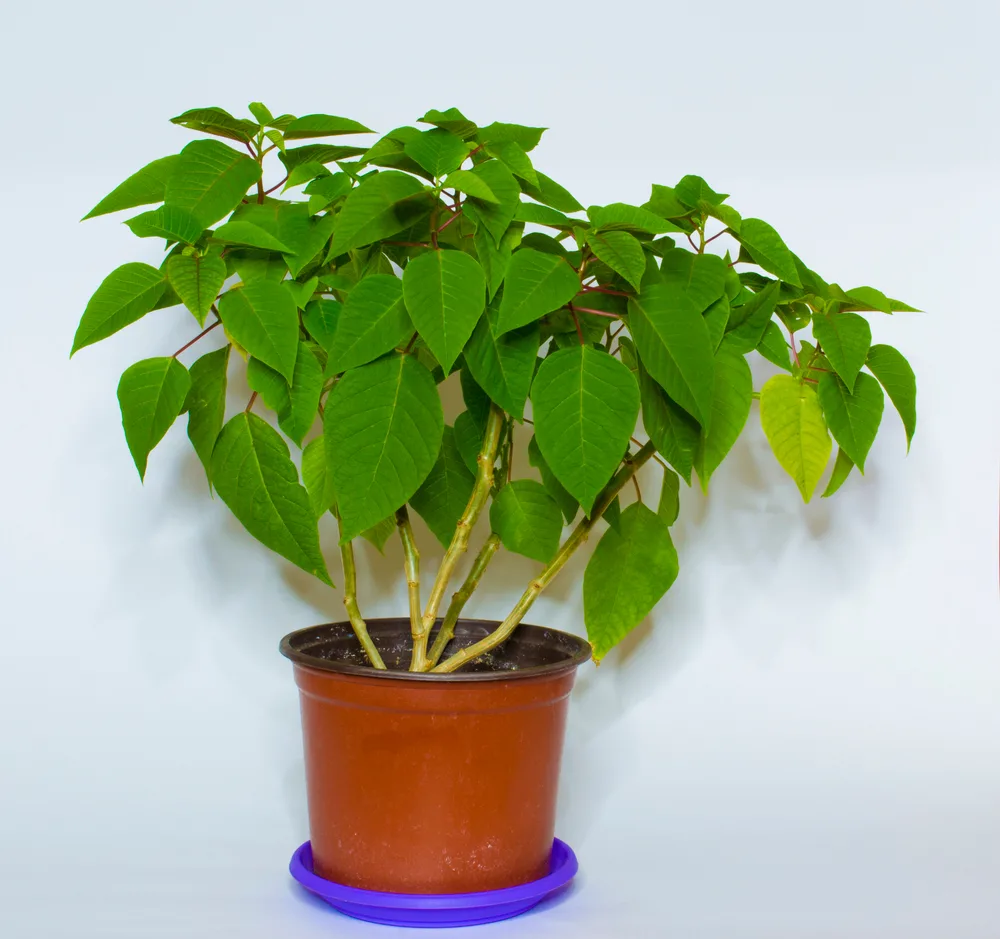
General care for poinsettia is the same as any tropical houseplant. And with some extra effort, you can encourage your poinsettias to rebloom – just in time for the next holiday season.
14. Let Plants Rest after Flowering
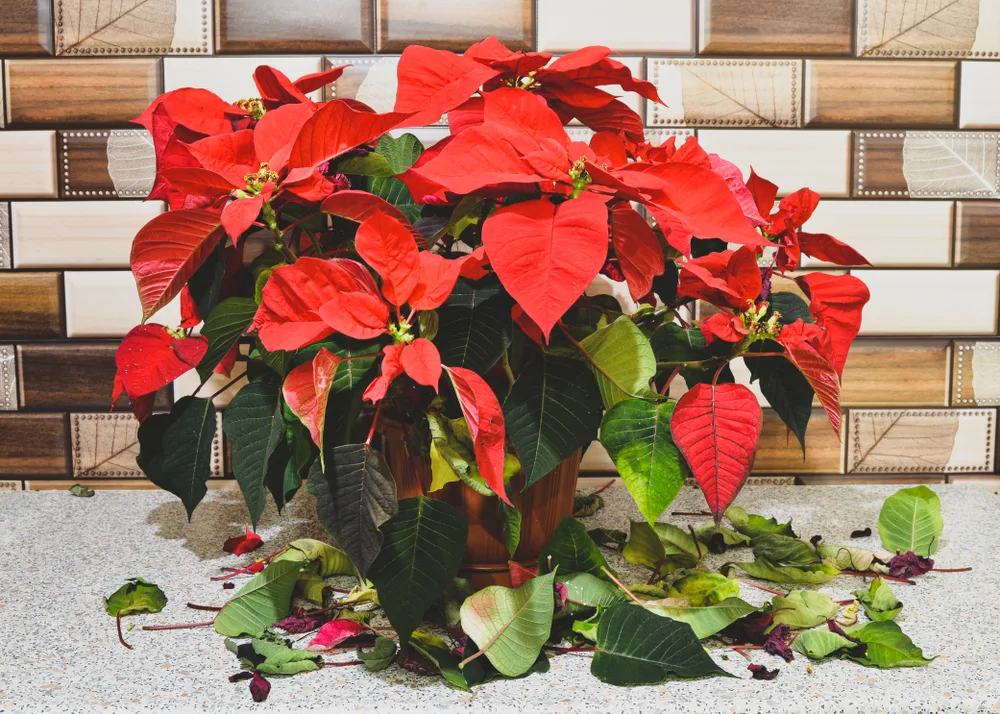
From January to March, poinsettia’s floral bracts will fade and start to drop off the plant. It may shed some foliage too, but don’t worry – this is a normal part of poinsettia’s life cycle.
Producing those spectacular blooms took up most of its energy and now it needs a period of downtime before spring.
Treat it the same as before – bright indirect light, consistently moist soil, and kept far away from drafts.
15. Fertilize Poinsettia When New Growth Appears
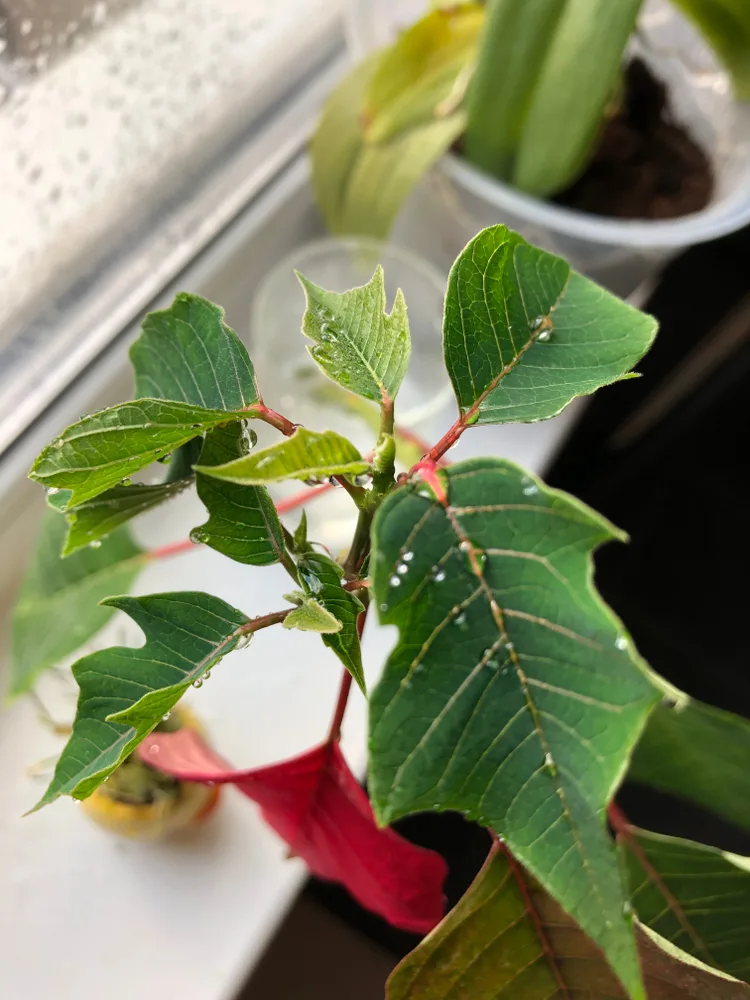
By April, poinsettia should be feeling fairly rejuvenated and will begin sprouting new shoots and leaves.
When you see a burst of new growth, it’s time to fertilize.
Use an all-purpose houseplant food for now, applied once every week or two until June.
16. Prune Plants for Bushier Growth
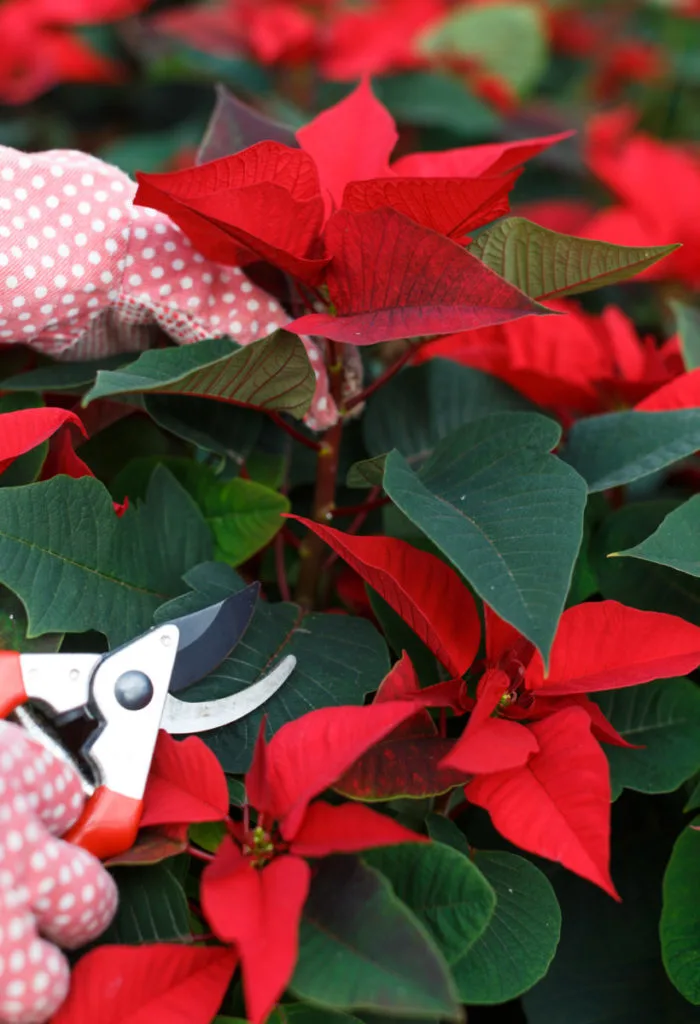
Normally, poinsettia grows from a single stem that culminates in one floral inflorescence.
Every time you prune and pinch poinsettia back, it will put out more and more branches – which means more blooming bracts.
To increase your poinsettia’s flower power, prune the main stem back to about 6-inches above the soil line. The cut should leave at least two leaves still growing on the plant.
It will sprout a lateral branch just below where you snipped. Once this new branch has at least two leaves, pinch off the tips of new shoots.
Continue pinching off tips, just above the second leaf, of every newly formed branch node until late August for the bushiest poinsettias.
While you’re at it, also prune away any long, leggy, or weak branches to maintain a full and balanced shape.
17. Propagate Poinsettia By Cuttings
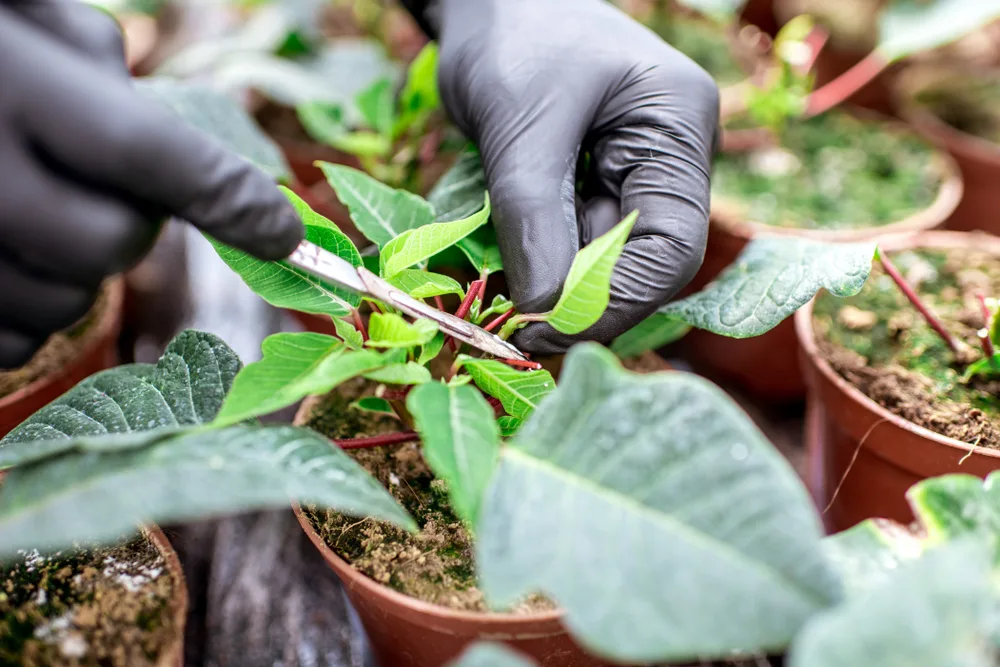
Want more poinsettia plants?
Instead of pinching the tips of shoots early on, let the new branches grow until they are 8 to 12 inches in length.
Snip off 4 to 6 inches for rooting, making sure there are at least two leaves on the softwood cutting and two leaves back on the branch.
Take your cuttings in the morning. Place stems, cut ends down, in a cup of lukewarm water for one hour.
Plant the cuttings in a light and airy seed starting mix with excellent drainage, such as coconut coir or leaf mold. To increase rooting success, try dipping your poinsettia cuttings in one of these natural rooting hormones before potting them up.
Give your new plants plenty of bright, indirect light.
Poinsettias will root faster in high humidity so consider spritzing plants with water daily or growing them under a humidity dome.
When the poinsettia cuttings have developed some roots, plant them up in an enriched potting soil mix with good drainage.
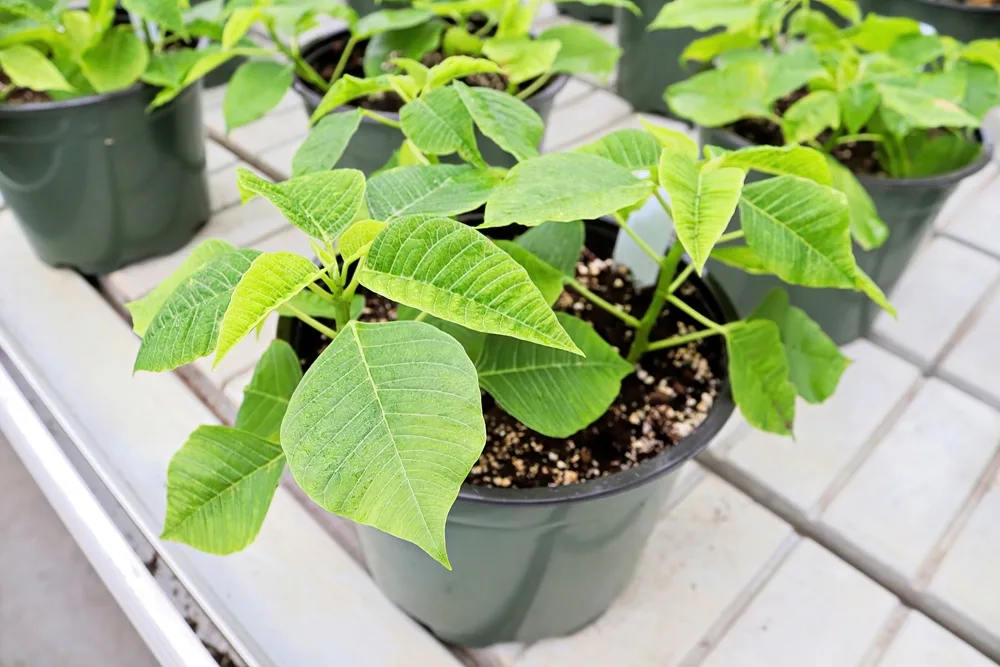
From here on out, caring for them is the same as the elder plant. The young’uns will even bloom at the same time as their parents.
For a more detailed guide to propagating poinsettia – and why it might actually be illegal to do so, read Tracey’s tutorial here.
18. Repot Plants If Necessary
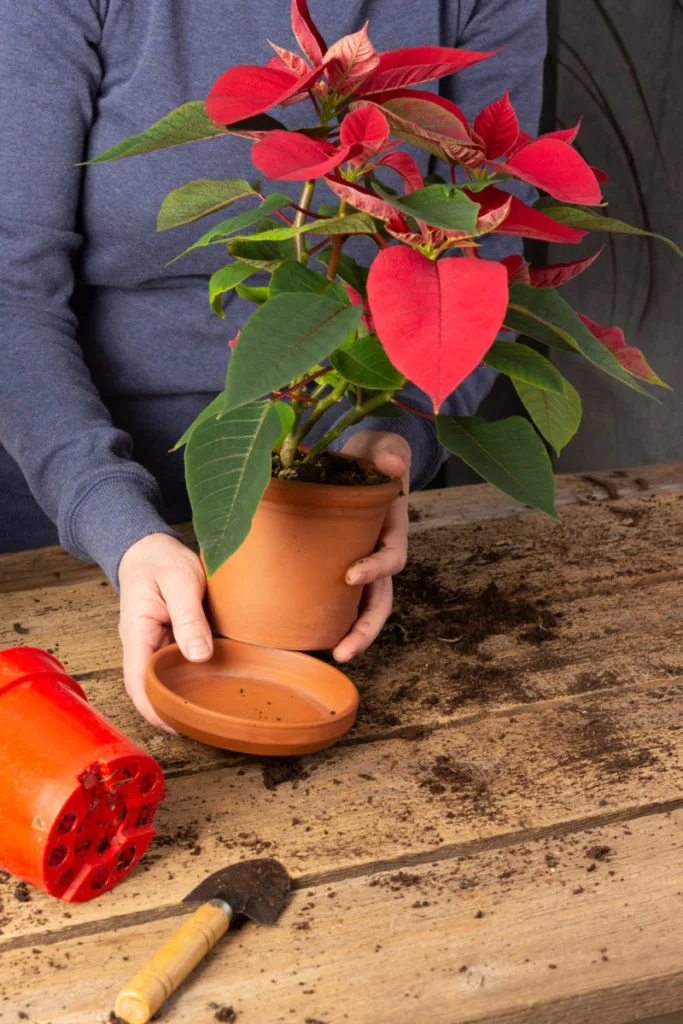
By the time May rolls around, your poinsettia should be sending out lots of new branches and lush green leaves.
Now is a good time to repot your poinsettia, if need be. This is especially true if you notice the plant suddenly stops growing or there are roots poking out through the drainage holes.
Go up a pot size or two and fill with fresh potting soil.
19. Bring Poinsettia Plants Outside Over Summer
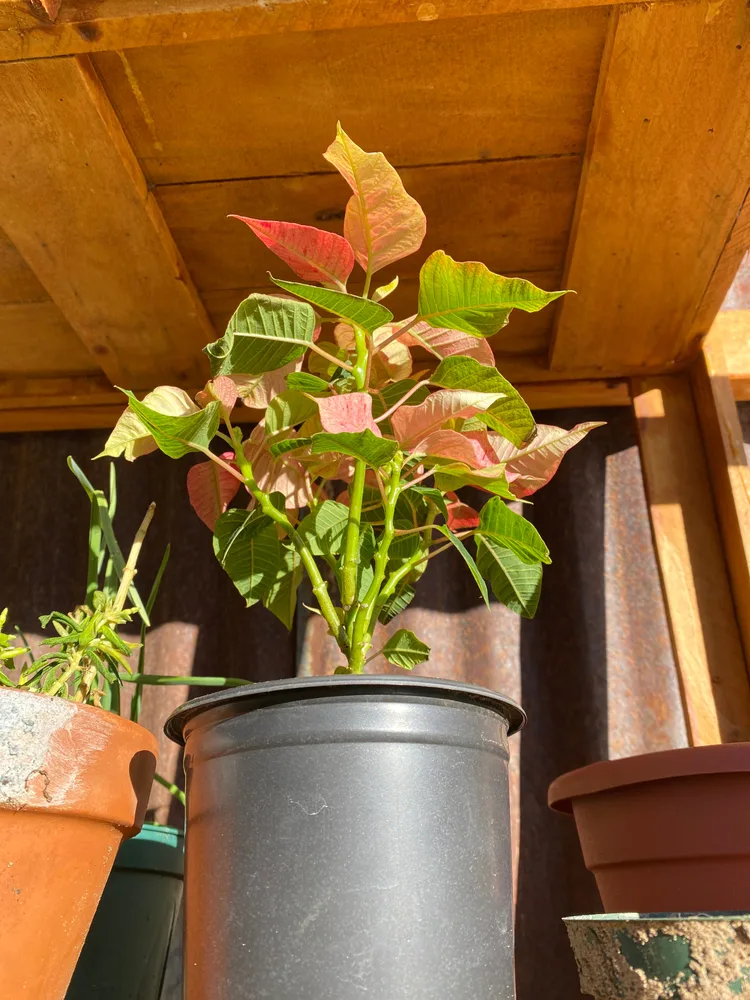
Poinsettia is only winter hardy in zones 9 to 11 – so for most of us, we’ll have to content ourselves with keeping it indoors as a houseplant.
But that doesn’t mean poinsettia can’t have her summers out of house. Outside, plants will explode with growth to make the tallest and bushiest of poinsettias.
Place potted plants in a spot with morning sun or light shade once outdoor temperatures average 60°F (15° C) and above.
From June to late August, fertilize every 3 to 4 weeks with a balanced N-P-K formula such as 20-20-20. Keep pinching off new shoots and water deeply only when the soil surface is dry.
When temperatures start to drop in fall, bring poinsettia plants back inside.
Of course, it’s perfectly fine to keep your poinsettia indoors over the warmer months too.
Getting Poinsettias to Rebloom
20. Place Plants in a Sunny Window
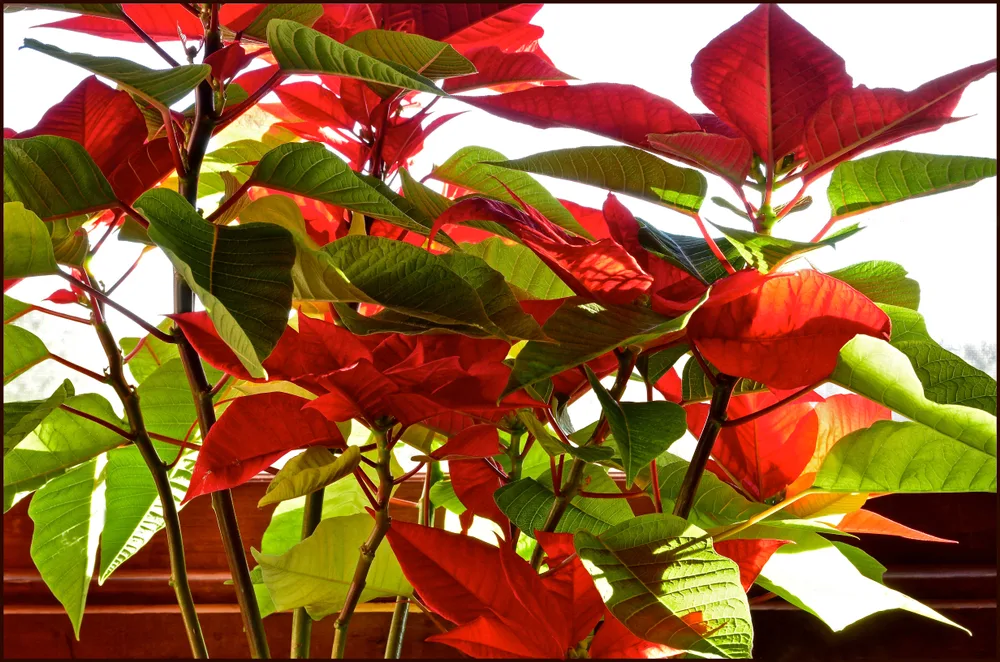
Encouraging your poinsettia to rebloom for the winter holidays isn’t hard to do, but it does take faithful execution!
The first step toward prompting flowers is to place plants in the sunniest window you have – a southern exposure is best.
Until now, poinsettias needed bright, indirect light. But the deepest colored bracts will only be produced when poinsettias are given full sun from late August onwards.
21. No Artificial Light After 5 p.m.
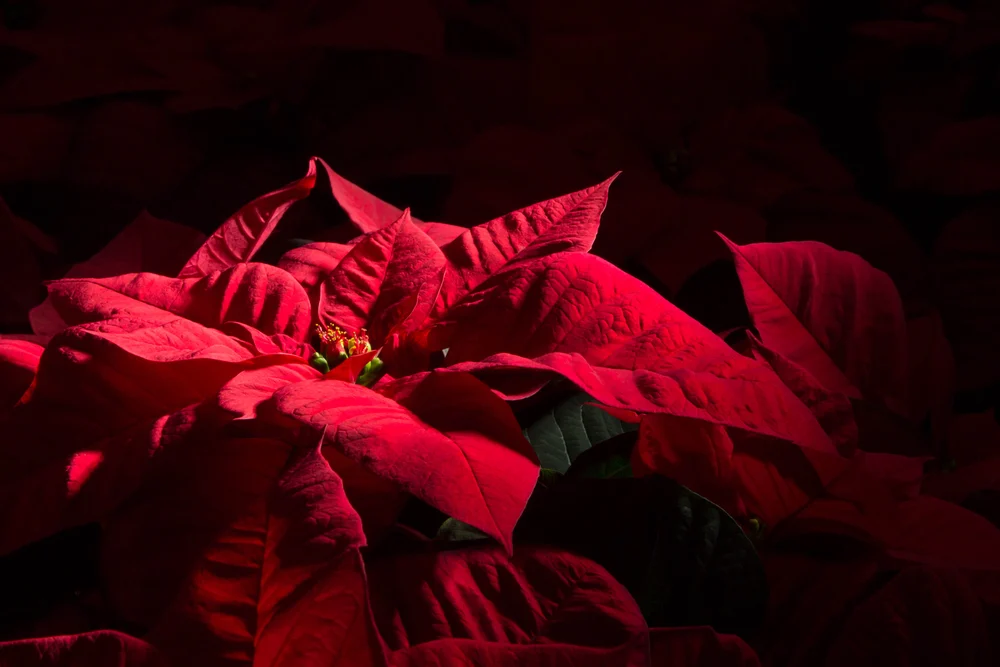
The flowering period will only be triggered in poinsettias when days are short and nights are long.
Starting in late September to early October, poinsettias must be kept in bright light for 10 hours and total darkness for 14 hours each day.
Just a brief flicker of a light bulb can be enough to disrupt or delay blooming, so take extra care to “light proof” the night cycle.
The Low Effort Way
An unused, spare room with good light during the day is the perfect spot to rebloom poinsettia.
It requires the least amount of work since you won’t need to move the poinsettia around or be beholden to daily reminders.
Place your poinsettia near the window and leave the curtains open. The plant will receive roughly 14 hours of darkness naturally from normal day-night cycles. Natural sources of light (like the moon or lightning) aren’t strong enough to interfere with blooming.
Tend to plants in the light of day but never go into the room after dark. Keep the door closed and the lights out. You might even want to go as far as unscrewing light bulbs in the room to avoid any momentary lapses.
The Harder Way
If you don’t have an extra room to devote to poinsettia blooming, you’ll need to create a dark space for poinsettias to spend the night.
One option is to move plants to a dark closet every evening. Use towels or blankets to block up any light leaks that can get through gaps in the door.
You’ll have to move your poinsettia into the closet each night at 5 p.m. and then haul it back to the sunny window at 7 a.m.
Alternatively, leave plants where they are but cover them up with something opaque, like a cardboard box. Lift the box off each morning and cover it up again in the evening.
Either way, setting daily reminder on your phone will be essential to keeping on top of poinsettia’s lighting schedule.
22. Wait for Full Color
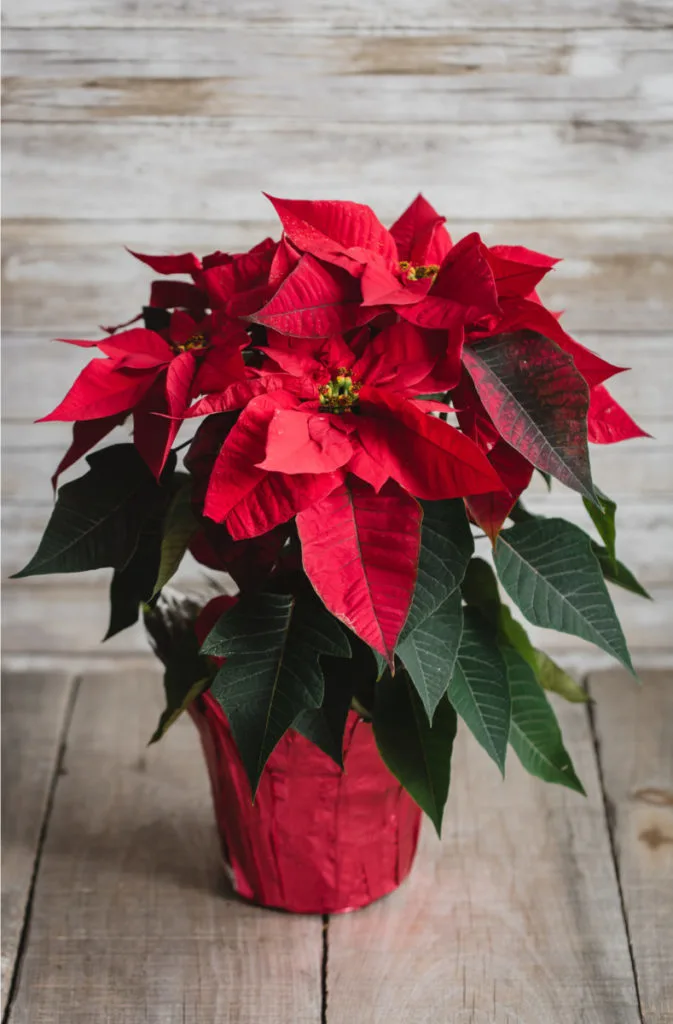
It can take anywhere from 4 to 8 weeks for flower buds to develop.
In the meantime, continue to drench poinsettias when the soil surface is dry. Fertilize plants monthly until mid-December.
You’ll start to see the cyathia forming and the bracts changing color. Continue with the long night and short day lighting until your poinsettia is bright and full of color.
When poinsettia is at its most beautiful, it can be put out on display for the coming Christmas festivities.
More Festive Houseplant Reading
10 Things Every Christmas Cactus Owner Needs To Know
12 Festive Houseplants To Decorate Your Home For The Holidays
11 Ways To Keep Your Christmas Tree Fresh For Longer

Get the famous Rural Sprout newsletter delivered to your inbox.
Including Sunday musings from our editor, Tracey, as well as “What’s Up Wednesday” our roundup of what’s in season and new article updates and alerts.

